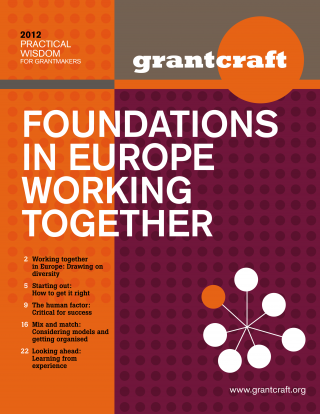Foundations in Europe Working Together
The practice of foundations in Europe is very diverse and the context in which they work may vary from country to country. This diversity enriches collaboration among funders in Europe, but it can also present challenges, particularly when foundations look to work together across borders.
Highlights
- Foundations in Europe working together: How is it different?
- Collaborative health-check
- Cartoons
- Case study on the European Foundation Initiative for African Research into Neglected Tropical Diseases
- A sample of European collaborations
What's in the Guide?
- Working together in Europe: Drawing on diversity
- Starting out: How to get it right
- The human factor: Critical for success
- Organising for collaboration: Mix and match
- Keep looking ahead: Learning from experience

-
Link to Foundations in Europe Working Together
Meeting the European Collaboration Challenge
As European integration evolves, foundations may increasingly benefit from — and thus be prepared to invest in — collaboration on issues that are decided upon or influenced by European level decision making:
Read more -
Link to Foundations in Europe Working Together
Hierarchies and Decision Making in Funder Collaboration
Dealing with hierarchies can be complicated when foundations in Europe work together. “I think in Europe more than in the U.S., hierarchy is an issue. If you want to address people, you have to know at which layer within the foundation you need to enter and at which level you can discuss what. It’s not like you can easily reach people.
Read more -
Link to Foundations in Europe Working Together
The Human Factor People Getting Along is the Key to Grantee Collaborations
Commitment to the collaboration.
Read more
Trust is not something that you whip up at short notice. The people involved must go beyond the content, engaging in personal working relationships. This requires a great deal of investment. “If I think about venturing in a possible new transnational project, first of all I would not underestimate, as I did at the beginning, the energy, time and effort required to be an active partner.” Presence and active participation in discussions and decision making is part of the trust-building process: “For it to work properly, you have to actually make the investment not only in contributing, but actually being present, so I think [our initiative] has worked and grown because the steering committee meets twice a year, and we all attend, and so we’ve got to know each other and trust each other.” -
Link to Foundations in Europe Working Together
Foundations in Europe Working Together How is it Different?
In Europe, values around philanthropy, about individual and collective responsibilities are different compared to the U.S., and philanthropy also varies enormously from country to country. Aside from multiple governments, laws, languages, history and contexts, there is a wealth of nuances and less obvious caveats that make the process of European foundations working together different:
Read more -
Link to Foundations in Europe Working Together
Getting Funder Collaboration Right How to Begin
Getting involved. Foundations become involved in the exploratory phase of a collaborative effort either as initiators or invitees. Experience suggests that it can take some time to get the right people around the table. Initially you might not even know who the right people are. So a certain degree of ambivalence or uncertainty, at least at the outset, is to be expected.
Read more
The practice of foundations in Europe is very diverse and the context in which they work may vary from country to country. This diversity enriches collaboration among funders in Europe, but it can also present challenges, particularly when foundations look to work together across borders.
Highlights
- Foundations in Europe working together: How is it different?
- Collaborative health-check
- Cartoons
- Case study on the European Foundation Initiative for African Research into Neglected Tropical Diseases
- A sample of European collaborations
What's in the Guide?
- Working together in Europe: Drawing on diversity
- Starting out: How to get it right
- The human factor: Critical for success
- Organising for collaboration: Mix and match
- Keep looking ahead: Learning from experience





